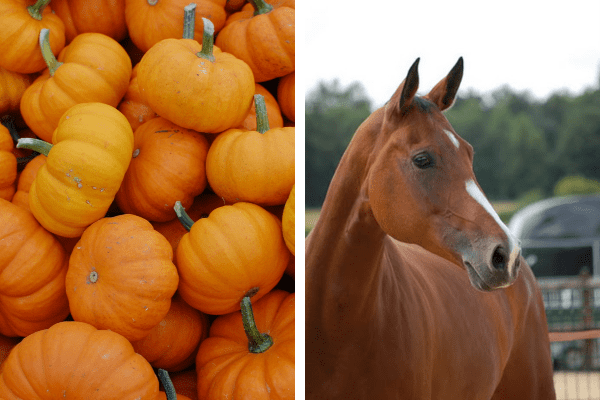When the question arises, “Can horses eat pumpkin?” the answer is a resounding “Yes!” But, as with all treats and dietary changes, it’s essential to dive a bit deeper into the context to ensure the well-being of our equine friends.
Exploring Nutritional Facts:
Vitamin: Pumpkins are widely known for their rich vitamin content, including an abundance of essential minerals like iron.
Vitamin A: An essential element for vision, immunity and skin health in horses. Adequate supply is key in providing sufficient eye support and supporting reproductive wellness.
Vitamin C: Although horses produce some Vitamin C themselves, adding additional sources like pumpkin can provide additional antioxidants that help support overall health, combat stress and slow the effects of aging.
Mineral Content: Minerals play an essential part in horse physiological functions – for instance: heartbeat regulation.
Potassium: Potassium regulates body water balance and supports muscle and nerve health. A lack of this essential mineral may cause hypokalemia, an illness marked by muscle weakness.
Magnesium: Magnesium plays an integral part in many biochemical reactions within the body and has an essential role to play in supporting nerve and muscle function and maintaining steady heartbeat rhythms.
Antioxidants: Pumpkins offer a range of antioxidants, such as beta-carotene, which converts to Vitamin A in the body and contributes to maintaining vibrant and healthy skin, eyes, and immune responses in horses.
Fiber-Rich: The high fiber content in pumpkins is incredibly beneficial for:
Digestive Health: Fiber can assist in keeping digestive processes running smoothly, helping prevent colic and constipation symptoms.
Weight Management: Fiber-rich foods are typically low in calories and provide a feeling of fullness, thus assisting in weight management by preventing overeating of higher-calorie foods.
Low-Calorie Content : Pumpkins offer essential nutrition without excessive caloric intake, making them an excellent source of essential minerals and vitamins without contributing to excessive caloric consumption. A Comprehensive View on Safety Concerns in Feeding Pumpkins to Horses

Safety in Feeding Pumpkins to Horses:
Begin With Gradual Introduction: It is wise to introduce any new food gradually so as not to shock their digestive system, starting out by offering small amounts and gradually increasing over days or weeks.
Observation: Vigilantly observe for any changes in behavior, digestion, or physical condition, ensuring the new food is not causing distress or allergic reactions.
Choking Hazards and Physical Safety Seeds and Stems: Seeds can pose serious choking hazards and even internal blockages, so always remove seeds as soon as you receive them and ensure any hard stems are also taken off before chewing to prevent dental issues or injuries from developing.
Digestive Health- Balancing Tricks: While pumpkins may provide many nutrients that benefit horses’ digestive health, they should never replace core components of a balanced diet for your horse. Establishing and maintaining nutritional equilibrium is paramount.
Offer Pumpkins In Moderation: Eating pumpkins in moderation helps prevent digestive upsets caused by sudden spikes in different nutrients or fibers.
Sugar Content: Horses, especially those prone to laminitis or obesity, should have restricted sugar intake. The natural sugars in pumpkins should be accounted for in their overall dietary management.
Quality and Freshness
Fresh Produce: Ensure pumpkins are fresh and free from rot or mold, which can harbor toxins harmful to horses.
Wash Thoroughly: Cleaning the pumpkin adequately to eliminate dirt, bacteria, or residual pesticides is critical to prevent ingestion of harmful substances.
Acceptance and Preference; Willingness to Eat: Although horses may initially resist trying new food items, don’t force them into trying something they are reluctant to. Give them time and let them explore on their own terms.
Avoid Pickiness: Incorporating treats intermittently into their routine feed regimen can prevent horses from becoming overly selective or opting for treats instead of their usual food source.
Establishing a Safe and Enjoyable Feeding Experience
Ensuring the introduction and provision of pumpkin treats are handled safely requires understanding each horse, their health, preferences and best practices for portion control, food preparation and quality assurance – which all come together for an enjoyable feeding experience.
Cooperating with a veterinarian or equine nutritionist is recommended in all instances to tailor feeding practices to the unique requirements of each horse, and ensure their overall diet remains safe, nutritionally adequate, and balanced.
Navigating the safety nuances of feeding practices with care and knowledge ensures that horses enjoy their treats while doing it in ways which support their overall health and well-being. If you require any further clarifications or information please feel free to ask! If any additional inquiries arise feel free to get in touch.

